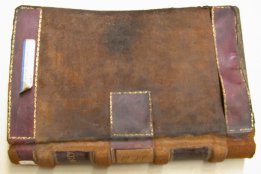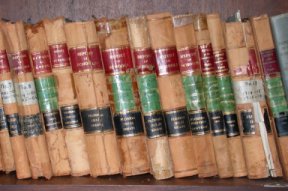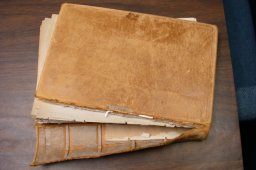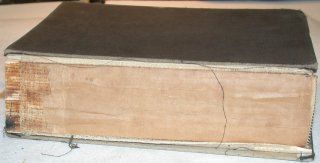The history of the book goes back hundreds of years. Written on parchment, vellum, papyrus, paper and other materials, words have conveyed history, philosophy, literature, language and every other endeavor of the human race. Early books belonged to the nobility, the ruling class, or the clergy, as each book was hand written in painstaking calligraphy. With the advent of the printing press in the fifteenth century, books became available to increasing numbers of people. Paper was a limited resource, however, being made from rags. Rag paper was very high quality, having few harsh chemicals involved in the bleaching and processing. However, as the demand for books grew, publishers searched for a less expensive way to make books.
In 1850, a German papermaker made the first wood pulp paper. As this process was perfected, wood became the most common material used to make paper. Although wood was cheaper and more readily available than rags, wood pulp paper had a few drawbacks, many of which are still with us today. Wood fibers are shorter than those in cloth rags, thus wood pulp makes a weaker paper. Wood also contains acids which attack its own fibers and causes the paper to become brown and brittle. Printing inks do not work very well on wood pulp paper, so chemicals are added to keep the ink in place. These chemicals, called "sizing," were acidic in the past. Today's paper sizing is more benign and can even add to the longevity of today's paper.
Book binding was originally a meticulous art form, with each book being hand sewn. To expedite book publication, publishers started having their books machine sewn. Eventually, books were merely glued to the inside of a spine instead of being sewn. Thus, the high demand for books has resulted in quantity, rather than quality, and in a large number of books that today are too fragile to use.
Luckily, some things can be done to prolong the life of your library. Proper handling, storage, and environment are the key elements to a long lasting book.
Environment
Temperature and humidity have a significant and lasting effect on books. Excessive levels of both can cause mold or mildew to grow on the books. If you see tiny, almost invisible insects inside one of your books as you are reading it, this indicates the presence of microscopic mildew particles. The little bugs live on mildew and are eating it out of your books.
High temperatures will also affect the acids inherent in old, brittle documents. The higher the heat, the faster the acids will work to make the paper brown and crunchy.

Leather bound book warped by changes in temperature and humidity. It is also suffering from "red rot."
Fluctuations in temperature and humidity are as bad as, or worse than, high levels of either. Changes in temperature and humidity cause paper and bindings to swell and contract, which they do so at different rates. This causes warping in the structure of the book. For instance, storing books above air conditioning units or heat vents can damage books due to the severe temperature and humidity changes that occur.
Leather in book covers is acidic and can be severely damaged by the environment and by pollution. Sulfur dioxide (for instance, from car fumes) when mixed with water (humidity) turns to sulfuric acid, which is a leading cause of “red rot” (deterioration that gives leather the appearance and texture of peach fuzz) in leather book covers. Leather book covers are also very attractive to mold spores.
In hot, humid conditions, good ventilation provides a cooling effect and inhibits mold from attaching quite so well. To facilitate air flow and filter the air in your library area, use a high efficiency filter such as a HEPA filter. HEPA filters can take pollutants, mold and dust out of the air. They are available at local hardware and department stores.
Attics are poor storage areas for books, as they tend to be very hot in the summer and very cold in the winter. Basements are also poor storage areas for books, as they tend to be damp and moldy. Other storage areas that can damage books are those that contain a washer and dryer or machinery that gives off heat. Cool and dry conditions are the best for books, slowing the acidic destruction of fibers and discouraging mold growth. The optimal temperature for books is 65° Fahrenheit with a relative humidity of 40%. This may be hard to achieve in hot Florida summers. Stability is most important. A good rule of thumb is, if you are hot and sticky, your books are, too. Store the most valuable items in areas of the house that are well air conditioned.
Light can damage books, especially by fading the bindings. It also adds to the "red rot" of leather covers as the ultraviolet rays break down the leather fibers. It is helpful to place the most valuable items in acid free storage boxes. However, it might not be practical to do that for all the books in your house. Books are best stored in the dark, or at least out of direct sunlight. UV filters are also available for coating windows and lights.
Storage and Handling Practices
Shelve books vertically, on metal or sealed wooden shelves. Green or unsealed wood gives off harmful gasses which can damage books. Leaning or slumping can cause permanent distortion to books and will damage spines. Store oversized and heavy books flat or with the spine down. Storing books with the fore-edge down may make it easier to read the spine, but it will also pull the text block out of the cover of the book.
Remember that books can break. Never pull a book from the shelf by its headcap (the top of the spine), as it will tear. To remove a book that is packed very tightly onto a shelf, push the ones on either side of it forward and grip the book on either side. If this cannot be done, press down firmly on the top of the text block and tip the book toward you. Do not carry too many books at once. For oversized books, be sure there is a big enough open space available to set them down. Juggling a large book in one hand while trying to clear off a space can be difficult and risks damage if the book is dropped.
Avoid writing on top of a book. Using a book as a writing surface can permanently emboss the cover of the book.
Keep food and drink away from books, crumbs and sticky spots attract bugs to paper. Cockroaches and silverfish enjoy munching on paper and will happily make holes in valuable items. Food and drink can also stain books permanently.
Reading in the bathtub can be relaxing, but the humidity, heat, and accidental falling into the bath can be extremely damaging to books. Take a replaceable paperback to the bath with you, not an out-of-print first edition (or library book).
Be aware of what you put into your book. Paper clips, clip bookmarks, post-it notes, pencils and other foreign matter can damage pages or put pressure on the spine of a closed book. Do not press flowers or place newspaper clippings in a book. Use flat bookmarks, and do not “dog ear” the corners to mark your spot.
Pressure sensitive tapes such as “magic tape” or “masking tape” have acidic adhesives. They will turn yellow, and will turn the paper yellow as well, before falling off and leaving behind a sticky residue. For valuable and old books, it might be worthwhile to hire a conservator to do repairs, using conservation methods, rather than tape. Some first editions can be worth hundreds of dollars, but the presence of tape on their pages will decrease their value.
Although it is best to not use any sort of tape on paper, there is no good home alternative to taping a torn page. For your modern, replaceable books, there are “archival quality” tapes available at art supply or scrapbook stores. Look for those which advertise that they have an acrylic based adhesive. One clue for this is that they've passed the PAT, or the Photograph Activity Test. The Photograph Activity Test is a test developed in conjunction with the American National Standards Institute (ANSI), and products which have passed the PAT must conform to very high standards. Tapes which have passed the PAT can be considered better for use on any type of document.
When applying tape to any tear, keep in mind the following tips: If possible, do not cover text or pictures, as the tape could potentially lift them straight off the page: mend in the margins. Use the least amount of tape you can possibly use to mend the tear (i.e. do not use a 6 inch strip to cover a three inch tear). If possible, snip small bits of tape from the roll and tack the tear together.
These books are in trouble for several reasons. They are "slumping," they are on a wooden shelf, they've been taped, and the bindings are suffering from "red rot."

Many old, leather bound books suffer from “red rot.” There is very little that can be done to counteract red rot, which is really leather dust. It is caused by acids breaking down the fibers in the leather. Once broken down, the fibers cannot be fixed. Some attempts were once made to moisten the leather of the books by using leather cleaners and conditioners. This did not help, but it did cause damage to the paper of the textblock and encouraged mold growth on the leather. It is best to box a red rotted book in an acid free box or phase box (a box made from acid free board or folder stock to serve as an enclosure for a book). These are available at archival and library supply websites. For more information on where to find these, please visit Conservation On Line: http://palimpsest.stanford.edu/.





